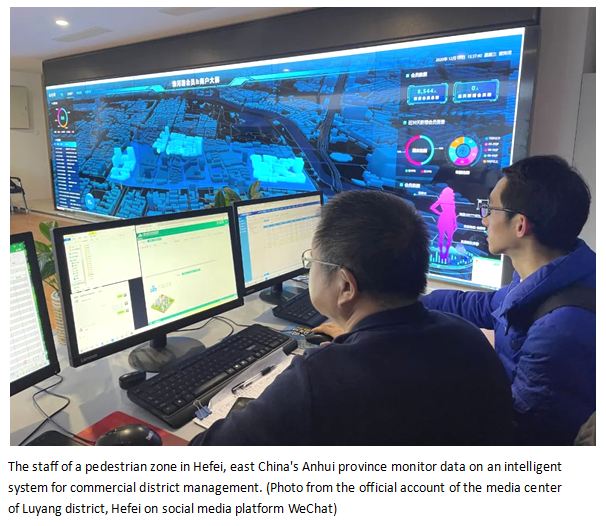By Wang Ke, Du Yifei, People’s Daily
China’s Ministry of Commerce recently unveiled the first batch of 12 national demonstration intelligent commercial districts and 16 national demonstration intelligent stores, which mirrored China’s determination to upgrade and transform commercial districts with technology.
Commercial districts across the country have established big data platforms for smart operation, and shopping malls are integrating online and offline retailing. They have constantly upgraded service facilities to build immersive consumption scenarios.
The accelerated application of digital technologies in the sector is bringing new experiences to consumers.
Intelligent commercial districts are an important part of the urban commercial system, as well as a carrier for promoting distribution innovation and fostering emerging consumption.
Intelligent commercial districts, centered on big data platforms and employing modern information technologies, build a smart service system for consumers, merchandising enterprises, operating institutions and government departments.
Such districts are able to obtain relevant data, offer consumption services, guide surrounding traffic and push information. Besides, they also integrate mobile payment, delivery, and public services.
In the northern section of Beijing Road, Guangzhou, south China’s Guangdong province, an intelligent robot is always seen standing outside a smart service center – the “brain” of the Beijing Road commercial district.
The center is not only a big data platform, but also a service platform for merchants and tourists. It provides 179 efficient and convenient government services in public security, civil affairs and human resources.
As one of the busiest commercial districts in Guangzhou, Beijing Road is visited by over 600,000 people per day on holidays. Therefore, finding parking space has always been a headache for citizens.
Under the coordination of the smart service center, parking lots in the commercial district are put into centralized management with inquiry and guidance services. Nowadays, citizens visiting Beijing Road can check available parking spaces on a WeChat mini-program, which saves much time and has improved the utilization of parking lots to over 90 percent.
The construction of intelligent commercial districts enriches smart scenarios and better promotes traditional consumption with digital technologies.
“Many promotion activities have been held in our shopping mall, but we still could not find customers. Digital management well solves the pain points of traditional retailing,” said Wu Shengjun, vice general manager of a shopping mall on West Nanjing Road in Shanghai’s Jing’an District.
The shopping mall records information about 200,000 products from over 500 suppliers in a digital management system it has developed, which presents real-time data on inventory and consumer habits. The system helps the mall adjust the structure of its commodities in a more targeted manner, and thus better meet the demand of customers.
Artificial intelligence and virtual reality technologies have built interactive and immersive consumption scenarios and offered convenient public services for many commercial districts. The tech-ish and fashionable commercial districts are bringing new experiences to consumers, and further activating their own development.
In June 2021, the first naked-eye 3D LED display of east China’s Anhui province was installed in a pedestrian zone in the province’s capital Hefei. The LED display has soon become a landmark, attracting huge attention from citizens. On New Year’s Eve of 2021, over 450,000 citizens in the city gathered around to celebrate the New Year.
A shopping mall owned by major Chinese retailer Suning.com Co. in Xinjiekou, a central business district of Nanjing, east China’s Jiangsu province, has upgraded its facilities, sales models and consumption scenarios, to offer new interactive experiences for customers. The digital transformation, integrated with technological and fashion elements, has more than doubled the mall’s average monthly foot traffic.
Experts believe that in the future, intelligent commercial districts will continue to bring more convenience to the people, coordinate the demands of market entities, upgrade themselves with modern information technology, and improve their management capacity, to better meet the diversified demands of consumers.













